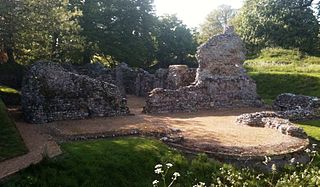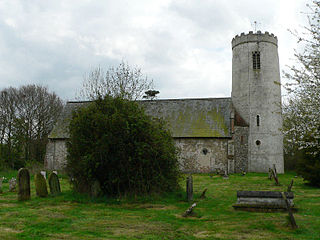Related Research Articles
Justus was the fourth archbishop of Canterbury. Pope Gregory the Great sent Justus from Italy to England on a mission to Christianise the Anglo-Saxons from their native paganism; he probably arrived with the second group of missionaries despatched in 601. Justus became the first bishop of Rochester in 604 and signed a letter to the Irish bishops urging the native Celtic church to adopt the Roman method of calculating the date of Easter. He attended a church council in Paris in 614.

Byrhtnoth, Ealdorman of Essex, died at the Battle of Maldon. His name is composed of the Old English beorht (bright) and noþ (courage). He is the subject of The Battle of Maldon, an Old English poem; J.R.R. Tolkien's short play in verse, The Homecoming of Beorhtnoth, Beorhthelm's Son; and a modern statue at Maldon.

The Bishop of Norwich is the ordinary of the Church of England Diocese of Norwich in the Province of Canterbury. The diocese covers most of the county of Norfolk and part of Suffolk. The bishop of Norwich is Graham Usher.

North Elmham is a village and civil parish in the English county of Norfolk. It covers an area of 7.41 sq mi (19.2 km2) and is located about 5 mi (8.0 km) north of East Dereham, on the west bank of the River Wensum. Including Gateley, the civil parish had a population of 1,428 in 624 households at the 2001 census; this increased slightly to 1,433 at the 2011 census.
Grimketel was an English clergyman who went to Norway as a missionary and was partly responsible for the conversion of Norway to Christianity. He initiated the beatification of Saint Olaf. On his return to England he became Bishop of Selsey and also for a time Bishop of Elmham. He was accused, by some, of being guilty of simony.

All Saints and St Nicholas, South Elmham is a civil parish in the north of the English county of Suffolk. It is 5 miles (8.0 km) south of the market town of Bungay and the same distance north-west of Halesworth and east of Harleston. The parish is in the East Suffolk district and is one of the parishes that make up the area around Bungay known as The Saints. It includes the settlements of All Saints, South Elmham and St Nicholas, South Elmham.
The Saints are a group of villages in the north of the English county of Suffolk, between the rivers Blyth and Waveney near to the border with Norfolk. The villages are all named after a saint, and either South Elmham or Ilketshall named after the 'hall of Alfkethill'. Known by locals as 'up the Parishes' the area is found between the market towns of Halesworth, Harleston, Bungay and Beccles.
South Elmham is a location in north Suffolk which was an ancient deanery dating back to the 7th century when it was given to the Bishop of East Anglia. South Elmham constituted a "ferthing", i.e a quarter of Wangford Hundred. This area included the parishes of Homersfield and Flixton.

Æthelberht, also called Saint Ethelbert the King was an 8th-century saint and a king of East Anglia, the Anglo-Saxon kingdom which today includes the English counties of Norfolk and Suffolk. Little is known of his reign, which may have begun in 779, according to later sources, and very few of the coins he issued have been discovered. It is known from the Anglo-Saxon Chronicle that he was killed on the orders of Offa of Mercia in 794.
Ealdwulf, also known as Aldulf or Adulf, was king of East Anglia from c. 664 to 713. He was the son of Hereswitha, a Northumbrian princess, and of Æthilric, whose brothers all ruled East Anglia during the 7th century. Ealdwulf recalled that when he was very young, he saw the Christian/pagan temple belonging to his ancestor Rædwald.
Spong Hill is an Anglo-Saxon cemetery site located south of North Elmham in Norfolk, England. It is the largest known Early Anglo-Saxon cremation site. The site consists of a large cremation cemetery and a smaller, 6th-century burial cemetery of 57 inhumations. Several of the inhumation graves were covered by small barrows and others were marked by the use of coffins.

Ilketshall St Margaret is a village and civil parish in the north of the English county of Suffolk. It is 3 miles (4.8 km) south of the market town of Bungay in the East Suffolk district. The parish is part of the area known as the Saints and had a population of 160 at the 2011 United Kingdom census.

All Saints' South Elmham is a village and former civil parish in the north of the English county of Suffolk. The parish was combined with St Nicholas South Elmham in 1737 to form the parish of All Saints and St. Nicholas, South Elmham. It is 5 miles (8.0 km) south of the market town of Bungay in the East Suffolk district. It is one of the villages that make up the area around Bungay known as The Saints.

Dommoc, a place not certainly identified but probably within the modern county of Suffolk, was the original seat of the Anglo-Saxon bishops of the Kingdom of East Anglia. It was established by Sigeberht of East Anglia for Saint Felix in c. 629–631. It remained the bishopric of all East Anglia until c. 673, when Theodore of Tarsus, Archbishop of Canterbury, divided the see and created a second bishopric, the See of Elmham associated with both North Elmham, Norfolk and South Elmham, Suffolk. The see of Dommoc continued to exist until the time of the Viking Wars of the 860s, after which it lapsed.

North Elmham Castle, also known as North Elmham Bishops Castle and North Elmham Bishops Chapel, is a ruined castle in the village of North Elmham, in the county of Norfolk, England.

The Kingdom of the East Angles, informally known as the Kingdom of East Anglia, was a small independent kingdom of the Angles during the Anglo-Saxon period comprising what are now the English counties of Norfolk and Suffolk and perhaps the eastern part of the Fens, the area still known as East Anglia.

All Saints Church is a redundant Anglican church in the village of All Saints' South Elmham, one of a group of villages jointly known as The Saints, in Suffolk, England. It is recorded in the National Heritage List for England as a designated Grade I listed building, and is under the care of the Churches Conservation Trust.

St Cross South Elmham is a village and civil parish in the north of the English county of Suffolk. It is in the East Suffolk district, close to the border with Norfolk and is 3 miles (4.8 km) east of Harleston and 4.25 miles (6.84 km) south-west of Bungay. It is one of the villages around Bungay known as the Saints.

St Peter South Elmham is a village and civil parish in the north of the English county of Suffolk. It is around 3 miles (4.8 km) south of the market town of Bungay in the East Suffolk district. It is one of the villages surrounding Bungay which make up the area known as The Saints.

The Bishop of Dunwich is an episcopal title which was first used by an Anglo-Saxon bishop between the seventh and ninth centuries and is currently used by the suffragan bishop of the Diocese of St Edmundsbury and Ipswich. The title takes its name after Dunwich in the English county of Suffolk. Previously a significant port, this town has now largely been lost to the sea.
References
- ↑ Campbell, James (1996). Atherton, Ian; Eric Fernie; Christopher Harper-Bill; Smith, Hassell (eds.). "The East Anglian Sees". Norwich Cathedral: Church, City and Diocese, 1096-1996. London: Hambledon Press.
- ↑ Plunkett, Steven (2005). Suffolk in Anglo-Saxon times. Stroud: Tempus. ISBN 0-7524-3139-0.
This article needs additional or more specific categories .(August 2024) |